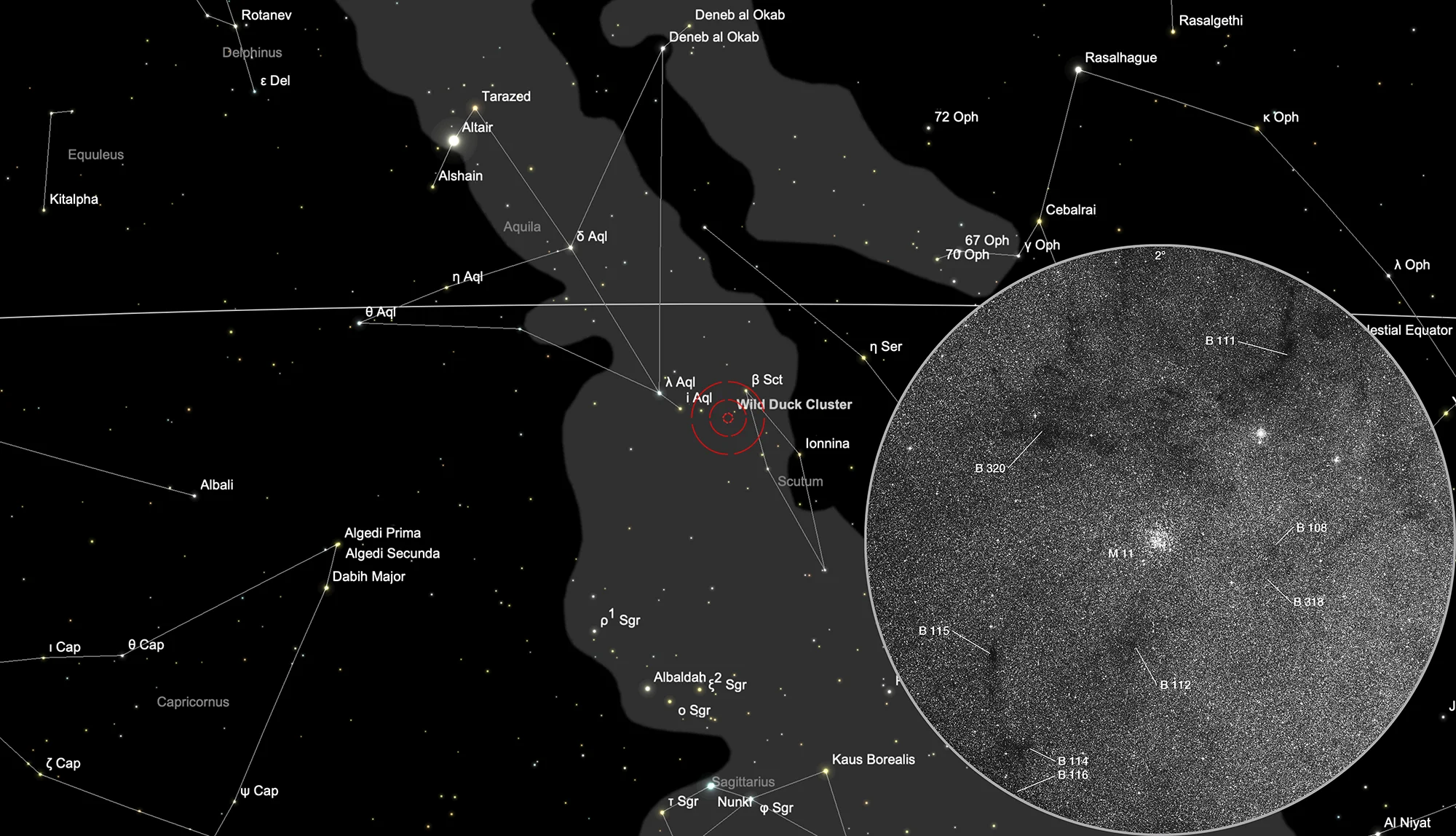Wild Duck Cluster (Messier 11)


History
This open star cluster was discovered in 1681 by Gottfried Kirch at the Berlin observatory. In 1715 Edmund Halley added the cluster to his short list of nebulous stars. The English cleric Wm. Derham seems to be the first who was able to break up the star cluster into single stars in 1732. Even Charles Messier was able to break up the cluster into single stars in May 1764, but since it looked like a comet in smaller telescopes, he added it to his list. Several stars of the cluster form a «V» with the tip pointing north. Admiral Smyth compared this figure to a flock of flying wild ducks, from which the nickname of the cluster derives: Wild Duck Cluster.
Physical Properties
Messier 11 is an exceptionally magnificent open star cluster that lies on the northern edge of the Scutum Star Cloud. It is one of the most compact in the Milky Way. In small telescopes with low magnification, it looks like a loose globular cluster at first glance. About 500 stars brighter than 14 magnitudes can be counted in M 11. At least 400 of these are real members of the cluster. The number of member stars brighter than 16.5 magnitudes is around 870. The total mass of the cluster is estimated to be around 2900 solar masses, which includes around 800 solar masses for undiscovered companion stars. Distances vary in the range of 5400 to 5800 light years. The sun at the same distance would appear to be just 15.9 magnitudes bright. It is obvious that all the stars of M 11 are luminous giants. Stars 11th magnitude shine with about 10'000 times the luminosity of the sun. According to the recorded colour magnitude diagram, most of the member stars are A and F stars of the main sequence, but at least a dozen are yellow and red giants. The age of the cluster is estimated to be around 500 million years.
The 10 arc minutes long central region of the cluster measures about 15 light years in diameter. The density is accordingly about 83 stars per cubic parsec, which corresponds to a mean distance from star to star of less than one light year. Residents of a planet in the centre of M 11 would see a sky above them with several hundred stars of the first magnitude and about 40 or so with an apparent brightness of three to 50 times that of Sirius. The density is only slightly less than that of loose globular clusters. There are still a few galactic star clusters with a similar density (e.g. NGC 2158 in Gemini and NGC 6791 in Lyra), but M 11 is the closest. M 11 is closer than the Scutum Star Cloud and is not directly embedded in it. [4]
| Designation | NGC 6705 |
| Type | OCL (I2r) |
| Right Ascension (J2000.0) | 18h 51m 05.0s |
| Declination (J2000.0) | -06° 16' 12" |
| Diameter | 11 arcmin |
| Visual magnitude | 5.8 mag |
| Metric Distance | 1.877 kpc |
| Dreyer Description | !, Cl, vB, L, iR, Ri, *9, st 11… |
| Identification, Remarks | h 2019; GC 4437; M 11; OCL 76; Wild Duck cluster |
Dark Nebulae
| Name | Type | RA (J2000.0) | Dec (J2000.0) | Size ['] | Identifiers |
|---|---|---|---|---|---|
| Barnard 108 | DNe | 18h 49m 36s | -06° 18' 00" | 3 × 3 | Barnard 108; [DB2002b] G27.11-2.45 |
| Barnard 111 | DNe | 18h 50m 00s | -05° 00' 00" | 120 × 120 | Barnard 111; [DB2002b] G28.36-1.94 |
| Barnard 112 | DNe | 18h 51m 06s | -06° 40' 00" | Barnard 112 | |
| Barnard 114 | DNe | 18h 52m 51s | -06° 55' 38" | Barnard 114; IRAS 18501-0659; LDN 514; [CB88] 157 | |
| Barnard 115 | DNe | 18h 53m 12s | -06° 36' 00" | 6 × 2 | Barnard 115; LDN 518; [CB88] 158; [DB2002b] G27.21-3.45 |
| Barnard 116 | DNe | 18h 53m 12s | -07° 06' 00" | 15 × 15 | Barnard 116; LDN 512; [DB2002b] G26.80-3.62 |
| Barnard 318 | DNe | 18h 49m 42s | -06° 23' 00" | 60 × 60 | Barnard 318; [DB2002b] G27.04-2.53 |
| Barnard 320 | DNe | 18h 52m 48s | -05° 51' 00" | Barnard 320 |
Finder Chart
The open star cluster M 11 lies in the constellation Scutum (Shield). The best observation time is March to December.
Visual Observation
400 mm Aperture: In the 21 mm Ethos eyepiece, the star cluster M 11 is well visible in the sea of stars of the Shield Cloud as a conspicuous and bright condensation. It resembles the appearance of a loose globular cluster. It is also worth magnifying more here to increase the contrast between the bright stars of the cluster and the fainter ones of the shield cloud. — 400 mm f/4.5 Taurus Dobsonian, Glaubenberg, 17. 6. 2023, Bernd Nies
